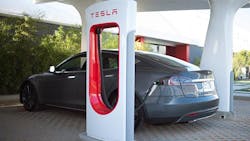Tesla Motors will expand its network of Superchargers, with 27 expected to open through the summer of 2013 and 98% of the U.S. and Canada covered by 2015. These 120-kW stations will deliver up to 50% battery capacity to Tesla’s Model S in about 20 minutes, which is 16 times faster than most public charging stations. Also, they are only compatible with the Model S, but the upcoming Model X will be compatible as well.
Related Articles
- Tesla Motors Unveils U.K. High-Power Charging Network
- Tesla Announces Model X Crossover
- Are Electric Cars Ready For Prime Time? I Think Not
“We will be adding Supercharger coverage in many areas over the next three to four months, installing our first Superchargers in the Pacific Northwest, Texas, Illinois, and Florida, with additional coverage in the Northeast and California,” said George Blankenship, Tesla Motors vice president of worldwide sales and ownership experience.
A properly equipped Model S can charge for free at any Supercharger. Supercharging is included in every Model S with an 85-kWh battery, and it can be added to any 60-kWh Model S for $2000, or $2500 if enabled after delivery. The Superchargers connect directly to the car’s charging port, bypassing onboard charging equipment.
Each station will include bays for four to 10 cars. They will be located near restaurants, shopping areas, and other popular destinations. Tesla will locate these facilities so drivers can drive from station to station without running out of charge. In fact, the company says that it will be possible to drive from Los Angeles to New York, Vancouver to San Diego, or Montreal to Miami using only the Supercharger network once it’s fully deployed.
“The bottom line is that the Model S combined with Supercharging works for a long road trip, even in a cold, snowy winter,” said Elon Musk, Tesla Motors chairman, product architect, and CEO. “Nonetheless, we will keep increasing the number of Superchargers, improving the software in the car (via over the air updates), and the technology behind the Supercharger itself.”
Some Supercharger stations use solar power now, and the company plans to add solar canopies to all stations. Also, all stations are GPS-located on Google maps to assist with route planning. According to Tesla Motors, general weather won’t affect Supercharging, though power might be affected in conditions surpassing 100°F.
“Without people even having to think about it or Tesla having to physically touch the car, the free long distance travel enabled by our Superchargers will steadily improve with each passing month,” Musk said.
